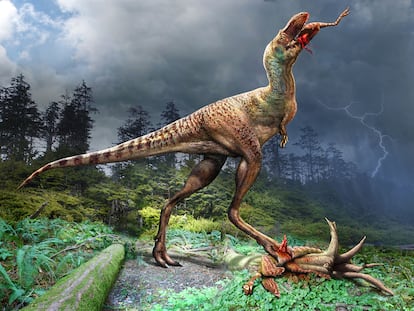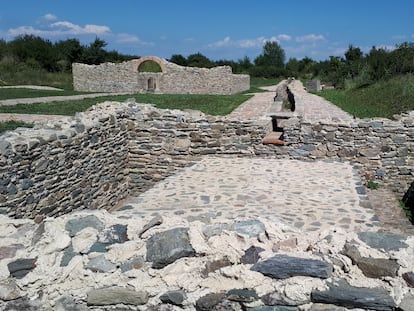The large height difference between the sexes suggests that in northern Europe boys were fed better than girls
Early Neolithic northerners were already taller than Mediterranean people, but the disparity between women and men was greater, which suggests that they gave preferential treatment to men

From a tall father and mother, the study of genetics predicts tall children. But it’s not so simple. At least 697 genetic variants are related to height, and that’s not all. Beyond one’s genes, the environment, and particularly diet, can affect the final result of one’s phenotype. Now, a complex study also points to the impact of culture and cultural practices. Its authors investigated the measurements of the first Europeans to engage in agriculture at the beginning of the Neolithic period, which took place between 8,000 and 7,000 years ago. Their research, supported by data from the remains of over 1,200 humans, indicates that people who lived in northern Europe were taller than Mediterranean people. And the study turned up something even more intriguing: the difference in size between men and women was much smaller in the south. Evidence is still lacking to confirm the theory, but all indications point to northern boys having been fed better than their female counterparts.
In the past, just as they are today, northern Europeans were taller than those of the Iberian Peninsula and the Italian Peninsula, but practically the same height as the Balkans. This is a finding suggested by the study of the remains of almost 1,300 people dating back to 8,000 to 6,000 years ago, whose results were published in the scientific journal Nature Human Behavior. To measure each individual, scientists used femur length as an approximation of height. “Anthropologists have been working for decades to develop equations to estimate a person’s height based on femur length,” says Samantha Cox, a researcher at the University of Pennsylvania and first author of the paper.
Sexual dimorphism is a constant in nearly all mammal species. Male lions are larger than lionesses, male gorillas weigh up to twice as much as female gorillas, and among moose, the males have antlers while females do not. When it comes to humans, dimorphism was present among our predecessor species, as attested by records like those from Atapuerca. But why are there differences between populations who, despite coming from the same origin, ended up settling in different parts of Europe? The arrival of Neolithic people from Anatolia (current-day Turkey) was the central element in the greatest shift in human history. With them came agriculture and animal husbandry, more sedentary lifestyles and subsequent urban development. Their arrival came by two routes, according to current scientific understanding: one followed the coast, passing through the Balkans, the north of what is now Italy, ending up in the Iberian Peninsula around 7,500 years ago. In the other, Neolithic people moved through the center of Europe, settling in the north of what is now known as Germany, the Netherlands and part of France a few centuries later. Now, a group of scientists has scoured previously unearthed sites to study the height of early Neolithic Europeans.
What causes this difference? Iain Mathieson, senior author of the study and an expert in demography and ancient DNA at the University of Pennsylvania, says that we just don’t know. “We don’t have the answer. It could be genetics, or it could be another environmental factor that we haven’t studied. In fact, the same thing happens today in that northern Europeans are taller than those in the south and we still don’t know why.” To find out more, they relied on DNA that had been recovered from the remains of hundreds of individuals and on population genetics (which is based on collective rather than individual differences). They took a map and placed the communities studied (Balkan, Neolithic people from southern-central Europe, northern Europeans and Mediterraneans) and compared them with genetic data from Anatolian farmers to the east and European hunter-gatherers to the west. The Mediterranean people must have been more closely related to the inhabitants of the territories where they arrived, since up to 11.4% of their genetic material came from hunter-gatherers. Meanwhile, the northerners had just 1.1%. All groups proved to be much closer to the Neolithic people of Anatolia than to the Mesolithic people of western Europe.
The study turned up another result for which scientists have no explanation, and which was unknown until now. Although each group had a similar ratio of sexual dimorphism, the northern women were shorter than those of the Mediterranean. Specifically, northern men’s femurs were on average 14% longer than those of the women, while among Mediterranean samples, the difference was a mere 5%.
Since the answer to this phenomenon didn’t lie in the DNA, researchers looked for it among environmental factors. The most decisive of such factor is diet. To investigate the impacts of food on the group’s height, the authors of the study relied on the presence of two isotopes linked to life’s basic elements: carbon and nitrogen. The variation in both can be detected in bone collagen, which is developed using molecules obtained from food. Hence, its analysis can tell us whether a person ingested more animal or vegetable proteins, or whether he or she ate more or less meat and fish. Such isotopic analysis was key in learning how the diet of the El Argar culture varied between its incipient social classes. The authors of the new study saw that there was a difference between the northerners and the other groups. But that did not explain the north’s high level of sexual dimorphism. So they went deeper into their research, digging into bones.
Taking on the duties of forensic scientists, the study’s researchers attempted to decipher if diets varied due to gender. An indirect strategy for checking this out is investigating whether both sexes received the same kind of foods. Proof of this should lie in the marks diet leaves on bones. By studying teeth enamel, they proved that half of northerners showed signs of hypoplasia, a dental weakness caused by deficient mineralization during the development of the teeth, which takes place during childhood. In the south, they also found signs of hypoplasia, but it did not rise above 20% of samples. Another indicator they studied is a pathology called porotic hyperostosis. This is a lesion that manifests itself in the spongy and porous cranial vault. It is a clear symptom of anemia and, again, appears during early growing phases. University of Lodz (Poland) paleopathologist Francesco Galassi, in comments unrelated to this study, says that the frequency of porotic hyerostosis and enamel hypoplastic are “common markers of stress in ancient populations.” Investigators concluded that northerners experienced greater dietary stress than Mediterranean people.
The cultivation of domestic cereals and legumes in a climate such as Anatolia or modern-day Syria was easier to reproduce in a climate like that of the Iberian Peninsula than in northern Europe. In fact, the sites inhabited by the first Neotlithic northerners, the people of the so-called banded pottery culture, show that they sought to settle in areas with fertile soils, compensating for lower solar radiation. Even so, their bones and teeth show they did not eat as well as other populations. Once again, scientists were faced with the double query: why were the first Neolithic men of the north taller, and their women shorter, than those in the Mediterranean region?
“We can’t be completely sure, but since only northern men were tall, we assume it’s because they were able to obtain more resources than women or southern European males,” says Cox, the paper’s lead author. Different treatment according to sex is the most logical explanation, but it’s only a hypothesis. “Given that there is more dietary stress in the north, this would make northern females even shorter, because resources were not evenly distributed.” That is, boy children were prioritized over girl children. Specifically, the ratio of sexual dimorphism, which among Mediterraneans was 1.05, was 1.14 in the north. Such a ratio is extremely high. Today, ratios higher than 1.10 are limited to societies that have traditionally favored boys over girls, such as India.
Iñigo Olalde, a researcher at the University of the Basque Country and the Ikerbaske Foundation, has published several papers on the first Neolithic people and the last European hunter-gatherers. For Olalde, the most interesting aspect of the recent study is the marked sexual dimorphism among northerners. “The difference in diet cannot be seen in adults, it is manifested in the body during development, during the growth period,” he says. Something must have been going on with the boys and girls, but “this is just a hypothesis,” he adds.
Galassi, the paleopathologist, underlines the study’s multidisciplinary approach, which combines ancient DNA, isotopes, bone pathology and femur measurements and “the audacity of its authors.” But he warns, as does Olalde, of the small size of its sample. It studied the remains of 1,269 humans, but researchers did not have data on every individual’s diet, isotopic ratio and enamel hypoplasia. The work seems to raise more questions than it answers. Galassi is reminded of Roman emperor Julius Caesar who, “in his Commentarii texts, while making an ethnographic and political digression regarding the primitive Germanic peoples, writes that he considered them a primarily masculine warrior society, in which men were taller, stronger and more muscular.”
Sign up for our weekly newsletter to get more English-language news coverage from EL PAÍS USA Edition
Tu suscripción se está usando en otro dispositivo
¿Quieres añadir otro usuario a tu suscripción?
Si continúas leyendo en este dispositivo, no se podrá leer en el otro.
FlechaTu suscripción se está usando en otro dispositivo y solo puedes acceder a EL PAÍS desde un dispositivo a la vez.
Si quieres compartir tu cuenta, cambia tu suscripción a la modalidad Premium, así podrás añadir otro usuario. Cada uno accederá con su propia cuenta de email, lo que os permitirá personalizar vuestra experiencia en EL PAÍS.
¿Tienes una suscripción de empresa? Accede aquí para contratar más cuentas.
En el caso de no saber quién está usando tu cuenta, te recomendamos cambiar tu contraseña aquí.
Si decides continuar compartiendo tu cuenta, este mensaje se mostrará en tu dispositivo y en el de la otra persona que está usando tu cuenta de forma indefinida, afectando a tu experiencia de lectura. Puedes consultar aquí los términos y condiciones de la suscripción digital.
More information
Últimas noticias
There is as much life left to discover on planet Earth as that which is already known
Dozens presumed dead, around 100 injured in fire at Swiss Alps bar during New Year’s celebration
Is porn for women different from conventional porn? We spoke to those who make it
Cartagena de Indias is sinking: What can the city do to mitigate it?
Most viewed
- Sinaloa Cartel war is taking its toll on Los Chapitos
- Reinhard Genzel, Nobel laureate in physics: ‘One-minute videos will never give you the truth’
- Oona Chaplin: ‘I told James Cameron that I was living in a treehouse and starting a permaculture project with a friend’
- David King, chemist: ‘There are scientists studying how to cool the planet; nobody should stop these experiments from happening’
- Why the price of coffee has skyrocketed: from Brazilian plantations to specialty coffee houses











































